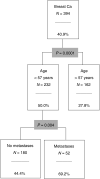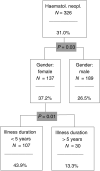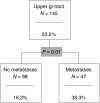Psychological problems of cancer patients: a cancer distress screening with a cancer-specific questionnaire
- PMID: 15238979
- PMCID: PMC2409853
- DOI: 10.1038/sj.bjc.6601986
Psychological problems of cancer patients: a cancer distress screening with a cancer-specific questionnaire
Abstract
The purpose of this study was to assess the psychological distress of cancer patients in a disease-specific manner as well as the demographic and medical variables that have an impact on the distress. Psychological distress was assessed with the Questionnaire on Stress in Cancer Patients revised version, which has been developed and psychometrically evaluated in Germany. It consists of items about 23 cancer-specific stress situations, which have to be answered in terms of relevance and amount of distress. A heterogeneous sample of 1721 cancer in- and outpatients was assessed. For the total group, the most important distress is the fear of disease progression. We consider between 23.4% (ca. of the upper gastrointestinal tract) and 40.9% (breast cancer patients) as highly distressed. The most distressed diagnostic subgroups are patients with soft tissue tumours and breast cancer patients. There are no global (general) stress factors, as the relevant demographic and medical 'risk factors' varied between the diagnostic subgroups. Cancer-specific distress questionnaires give a more precise insight into patients' experience than general or psychiatric questionnaires. They are not only used in large screening studies but also in routine medicine, particularly when the objective is to identify patients to whom psycho-oncological support is to be given.
Figures







References
-
- Aaronson NK, and the EORTC QoL-study-group (1991) The EORTC core quality of life questionnaire. In Effect of Cancer, on QoL, Osoba D (eds) pp 185–203, Vancouver: CRC Press
-
- Bergner M, Bobbit RA, Carter WB, Gilson BS (1981) The sickness impact profile: development and final revision of a health status measure. Med Care 19: 780–805 - PubMed
-
- Bonevski B, Sanson-Fisher R, Girgis A, Burton L, Cook P, Boyes A (2000) Evaluation of an instrument to assess the needs of patients with cancer. Cancer 88: 217–225 - PubMed
-
- Carlson LE, Bultz B (2003) Cancer distress screening. Needs, models, and methods. J Psychosom Res 55: 403–409 - PubMed
-
- Cella DF, Tulsky DS, Gray G, Sarafian B, Linn E, Bonomi A, Silberman M, Yellen SB, Winicour P, Brannon J (1993) The functional assessment of cancer therapy scale: development and validation of the general measure. J Clin Oncol 11(3): 570–579 - PubMed
MeSH terms
LinkOut - more resources
Full Text Sources
Medical

